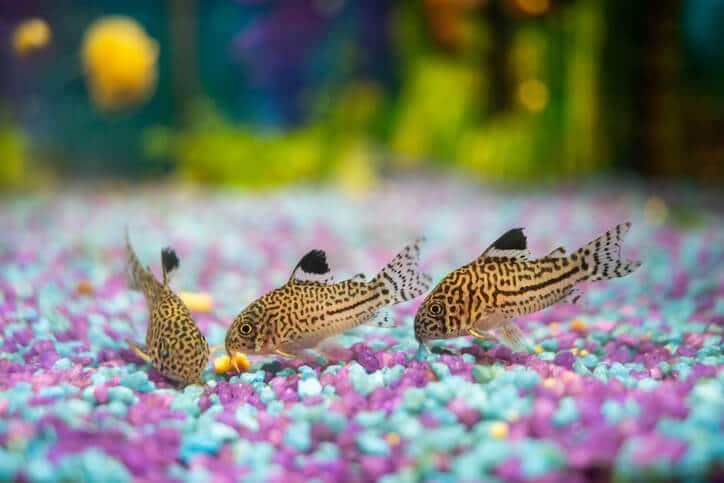Cory Catfish are one of the more expressive types of fish to have. They’re active, friendly, and very docile, which makes them great companions in a community tank. However, sometimes they swim around in an awkward way that some fish keepers find alarming.
The reason why your Cory Catfish is swimming crazy is because of stress or dissatisfaction with their environment. There are many possible culprits for this behavior such as bad quality water, poor tank conditions, improper feeding, or tank mates.
Why Is My Cory Catfish Swimming Around So Much?
When a Cory Catfish flits around its home erratically, observe and note how it’s swimming, the direction it’s going in, and its overall appearance.
Up ; Down
When you see your catfish traveling in a vertical line inside the aquarium, this is normal for them to do.
Sometimes they notice their reflection in the glass and it’s their way of trying to understand what it is they’re seeing. Other times they’ll come up to the surface for a little air or they’re swimming like this because it’s fun.
Another possibility could be that they’re ready to spawn. Your Cory Catfish is advertising it to any available and willing mates.
Related Read: Top 7 Reasons Why Fish Swim Up And Down In The Tank
Staying at the Top of the Tank
When you notice your Cory Catfish constantly swimming to the surface and clearly trying to get air, this means there’s poor air quality within the tank. There’s more oxygen at the top and so the fish will return to it more than they should.
Ensure you check the water parameters, test the water and temperature. Also, make sure you have an air pump or air stone. This will ensure enough oxygen infiltrates the tank.
Other Shapes ; Patterns
While it might not be anything to worry about, seeing your Cory Catfish swim in unusual patterns or shapes does warrant observation. There could be something more going on inside the aquarium.
But, it’s important to understand these fish love to have fun and explore, so they’ll swim in a bizarre fashion because it’s something new or different to do.

Read: Are Cory Catfish Hardy? What Are The Hardiest Cory Catfish?
Why Is My Catfish Swimming Frantically?
There are moments where you might notice your catfish swimming in a way that’s very concerning. You recognize that the behavior is odd and not normal.
The reason why your catfish might be swimming frantically around the tank is because it’s not happy with the water parameters or the environment in general.
While most catfish are very tolerant of a wide range of conditions and parameters, ensure you’re providing the following conditions for Cory Catfish:
- Tank Size – At least 15 gallons + one to two gallons per catfish
- Substrate – Soft and Gentle (sand or very smooth, small pebbles)
- Temperature – 74°F to 80°F
- dKH – 54 ppm to 180 ppm
- pH Balance – 7.0 to 8.0
- Plants – Dwarf hairgrass, penny warts, Amazon swords or crypts
- Water Flow Pressure – Medium, but not direct
- Water Changes – Once per week 10% to 25%
They’re Bottom Dwellers
Most Cory Catfish love to hang out at the bottom of the tank, they’re catfish after all.
The substrate should be sand or something similar. If there’s any amount of coarseness or roughness, they can cut their bodies, fins, and gills.
Be sure you inspect them for any little cuts or damage that might come from the substrate.
Also, make sure there’s at least two inches of substrate covering the bottom of the tank. They love to dig and roll around in it. If there’s not enough, it can cause them to swim around in a funny manner.
Observing Tank Mates ; the Cory Catfish
If you know the conditions are right and the fish still swims frantically around the tank, observe the behavior of other tank mates.
Are any of the other fish bullying, antagonizing, or being aggressive with your Cory Catfish?
If so, there might be a territory issue going on or you’re not feeding enough for all the fish in the community.
Other than that, there may not be anything to worry about. Sometimes Cory Catfish are funny creatures and they do all sorts of strange things. Most of the time it’s to keep themselves entertained but other times it could indicate something interesting outside of the tank they notice.
Do Cory Catfish Swim A Lot?
Cory catfish are known for their active nature and can often be seen swimming energetically in aquarium tanks.
As a fish owner, I have noticed that whenever I wake up in the morning, my cory catfish are already in motion. Throughout the day, however, they tend to prefer the bottom part of the tank or find comfort beside the cool plants.
Corys are generally considered to be highly active fish. Although occasional moments of stillness may occur, these fish are naturally playful and curious, which leads them to engage in frequent swimming activities within the tank.
So, if you see your cory catfish swimming a lot, it’s usually a completely normal behavior for these fascinating aquatic creatures. However, it’s important to consider any potential stress-related issues in the tank. Factors such as an overcrowded tank, improper water parameters, or insufficient food supply can contribute to stress in the fish.
Are Cory Catfish Sensitive To Water Changes?
Cory catfish, like other aquarium fish, are sensitive to water changes. If you perform a sudden large water change, it’s common to see your Corydoras behaving erratically due to the stress caused by the abrupt environmental change.
Regular water changes do benefit the aquarium ecosystem. It’s recommended to change 10% to 25% of the water weekly, depending on the number of fish. This process removes waste and introduces fresh water, refreshing the tank.
Avoid making sudden water changes to prevent affecting the fish’s environment and their ability to adjust. After a significant water change, it’s not unusual for fish to swim near the tank’s surface, gasping for air due to the stress caused by the sudden change.
Additionally, adding untreated water in the tank can also lead to erratic behavior in cory catfish. Sudden water parameter changes significantly affect these fish, causing stress and discomfort.

To ensure the well-being of your cory catfish, use a high-quality water conditioner during water changes. I recommend Seachem Prime (available on Amazon), which eliminates harmful chemicals like chlorine and detoxifies substances such as nitrite, nitrate, and ammonia.
Check out this informative guide for more information on how long to wait before introducing fish after adding a conditioner.
And refer to this guide if you’re interested in detailed guidance on the dosage of Seachem Prime.
Why Is My Cory Catfish Swimming In The Middle Of The Tank?
Cory catfish, typically bottom-dwellers, explore all parts of the tank, including the middle. New corydoras need time to adjust to their surroundings, which can take up to two weeks. During this period, they may swim more in the middle. So don’t worry, eventually, they return to their normal behavior of dwelling at the bottom and searching for food in the sand.
Sometimes cory catfish swim to the top of the tank to gulp air via posterior intestinal aerial respiration.
To put it simply, when a cory catfish requires air for breathing, it swims to the surface and takes in a mouthful of air. This air is absorbed into the bloodstream as it passes through the intestine. The fish then releases the remaining air through its anus.
While they are non-obligate air breathers, they benefit from it, especially in low-oxygen habitats.
Some cory catfish even engage in social air-breathing, swimming to the surface and returning to their original position in the tank. This behavior is normal and don’t worry about it.
I have seen my albino corys exhibiting this behavior time and again as if they are doing some race of swimming to the top of the tank and returning back again one after another. It’s really a great scene to observe their unique behaviors in the tank.
If you see your cory catfish swimming in the middle or occasionally going to the surface, rest assured that it’s a natural part of their behavior and adaptation to the environment.
How Do You Know When a Cory Catfish Experiences Stress?
Erratic and frantic swimming is only one symptom of a stressed Cory Catfish. Other things will also accompany the strange behavior with things like lack of appetite, white spots all over its body, gasping for air at the surface of the tank, hiding all the time, having a pale color, lethargy, gill discoloration, or rapid movement in the gills.
When you notice any of these things in conjunction with strange swimming patterns, you have to figure out what’s wrong. This means checking the water parameters, observing other tank mates, and ensuring your fish is getting enough nutrition.
Make Sure They Have Their Own School
Also, even when you know the parameters are correct and no other symptoms appear but they look stressed all the same, you may not have enough of its own kind in your tank.
Cory Catfish must have at least six other buddies from their breed to be happy. Learn more about how many cory catfish should be kept together in this guide.
Fortunately, it takes a lot to stress out these peace-loving tank species. When Cory Catfish have everything they need, they thrive beautifully. Check out the ultimate Cory Catfish happiness guide here.
Cory Catfish are notorious for being silly, playful, and providing pure entertainment.
What Is Normal Cory Catfish Behavior?
Glass surfing is a normal behavior for Cory Catfish. This is the concept of the fish swimming up and down the side of the tank. Oftentimes, this isn’t anything to have concern over. It’s normal for these catfishes to swim all over the place when:
- They first come into a new tank.
- You performed a significant water change.
- You are nearest to the tank.
- When the fish are hungry and want/expect food.
- There’s a substantial alteration with water parameters.
Although you should keep an eye on your fish when any of these situations occur, the catfish will adjust and change their swimming habits in a short period of time. It’s when the erratic swimming continues for far longer than it should that there is the most likely reason for concern.
Otherwise, these are very peaceful types of fish and it’s not common for them to become aggressive or have a difficult temperament.
Plus, they’re very endearing and accommodating, which makes them excellent members in a community tank.
They won’t even fight back when attacked, so it’s not ideal to have aggressive breeds of fish housed with them.
Conclusion
Cory Catfish are easy to care for, as long as they have everything they need. This includes plants, plenty of food, friends, and peaceful tank mates.
But, if you notice them swimming in crazy and frantic ways, pay attention to signs of stress or unhappiness. Measure the water parameters and observe the behavior of all aquatic life inside your delicate ecosystem.
Read Next:–
References
Aqueon – Care Guides – Corydoras Catfish
Fishkeeping World – How To Know If Cory Catfish is Stressed
National Geographic – How These Fish – ‘Tiny Tanks Of The Amazon’ – Survive Piranha Bites
ResearchGate – Aerial Respiration in Corydoras Aeneus
Hi! I’m Praveen Ghoshal, the founder of eFishkeeping.com. Inspired by my Dad, I got interested in fishkeeping when I was a kid. Since then, I have been involved with this hobby. Currently, I have 3 fish tanks at our home, and I enjoy this hobby with my full family. Read more about me here.







